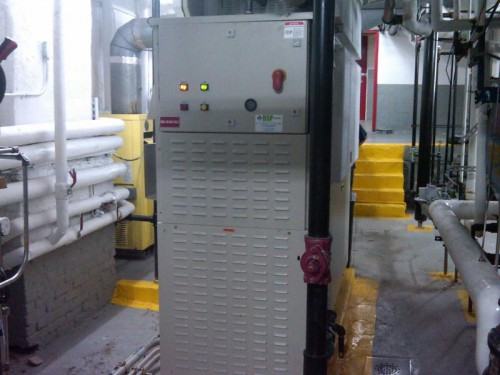Microturbine: Another Columbia Sustainability First

Walk into the lobby of the Columbia residential building at 600 West 113th Street and you'll see four brass candelabra - their 64 bulbs powered by electricity from a microturbine, Columbia's latest and highly significant energy conservation and greenhouse gas reduction effort.
Turn on a faucet in this building and any of the others along Broadway between 112th and 113thStreets - another Columbia residential building at 601 West 112th Street, four restaurants, two dry cleaners, a hair salon, a florist - and you'll have water heated by the same microturbine, located in the basement of 600 West 113thStreet.
"As far as I know, this is the first such installation for any institution of higher learning in New York City," says Mark Kerman, Assistant Vice President, Residential Operations, who is overseeing this project and similar ones in four buildings on the Morningside campus.
A microturbine is best described as a mini electric generator, Kerman says. Its operation is relatively simple: Columbia's new turbine, built by Capstone Turbine Corporation, is housed in an 8-ft.-high container that's 30 inches wide and 9 ½ ft. long, and uses natural gas purchased from Consolidated Edison to create about half of the electricity used in the building. Exhaust from the turbine is forced into a heat-recovery module through which water is circulated and heated.
In late May, when the microturbine had been operational for several weeks, it was providing electricity for 600 West 113th Street, and the sole source of hot water in the Columbia-owned buildings on the west side of Broadway between 112th and 113th Streets, thus eliminating the need for the boiler. "Just doing what we're doing we don't need a domestic hot-water heater in the non-heating season," says Robert F. Germain, Jr., PE, PC, President and CEO of the company that bears his name and who designed the microturbine system for Columbia.
Come winter, should more energy be needed to produce steam heat, the boiler will kick in, though it will run significantly less than in prior years, says Malik Nawaz, building superintendent. Residents won't be able to see the difference, either in hot water or building temperatures, Nawaz says.
The estimated annual reduction in greenhouse gas emissions will be equal to taking at least 45 cars off the road each year, Kerman says. This reduction is part of Columbia's commitment to PlaNYC, Mayor Michael Bloomberg's overall sustainability effort for the city.
"The microturbine project is perfect for greenhouse gas reduction in an urban setting like New York City with its multifamily residential housing," says Nilda Mesa, Assistant Vice President, Office of Environmental Stewardship.
A conservative estimate projects savings of about $100,000 per year on electric and heating costs, thus setting up about a four-year payback period.
A sophisticated new computer system controls the microturbine and, at 15-minute intervals, records all data on the amount of energy produced by the microturbine and used by the building. This information is monitored by RSP Systems, the local distributor for Capstone Turbine Corporation. It is also used to fine-tune the microcomputer's operation as well as provide year-to-year energy consumption comparisons.
By summer's end, the second microturbine will be up and running at 542 West 112th Street. By year's end, Armstrong at 2880 Broadway, and Carlton at 362 Riverside Drive, will also have microturbine power.
Installations will be easier going forward, Kerman says, as various regulatory agencies become more familiar with gas and electric connectivity as well as safety issues. The process to obtain the operating permits at 600 West 113th Street took several months following the turbine installation, as building superintendent Nawaz became licensed to oversee the turbine and Con Ed, the New York City Department of Buildings and the New York City Fire Department completed their inspections.
Robert Germain, who has designed about 150 boiler projects for Columbia since 1984, says he's "very pleased with this operation. From all preliminary information, it's going to exceed my expectations regarding cost savings and energy saving. I never expected it to handle the entire hot water output."
For more information on Columbia's green initiatives, please visit: http://www.environment.columbia.edu/